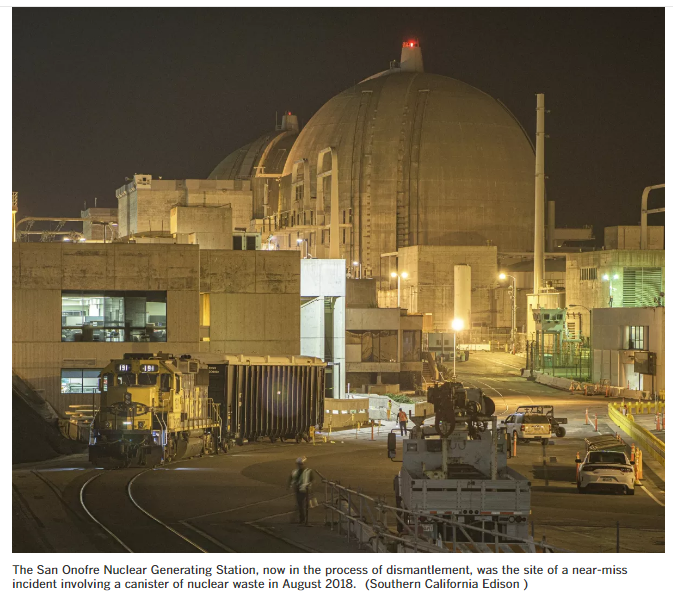Lawsuit over internal records of 2018 ‘near miss’ at San Onofre nuclear plant moves forward
Case dates back to ‘serious near-miss’ incident involving a canister filled with nuclear waste.
BY ROB NIKOLEWSKI
MARCH 7, 20235:43 PM PT
A lawsuit seeking the release of internal communications surrounding an incident nearly five years ago at the San Onofre Nuclear Generating Station will continue after a ruling Monday by a federal judge in San Diego.
U.S. District Judge John A. Houston turned down a motion by the Nuclear Regulatory Commission to toss out the case brought by San Diego attorney Michael Aguirre.
The judge also determined that while the NRC was within its rights to redact some documents it had previously released, the federal regulator “has not provided sufficient evidence” to show that it made a reasonable effort to search for documents requested by Aguirre under the Freedom of Information Act.
The case is “still alive,” Aguirre said of the judge’s decision. “We’re going to keep digging hard to find the documents that will hopefully inform the public about what happened.”
A spokesman for the NRC said the commission is reviewing the judge’s order and had no comment to make on it.
The case dates to Aug. 3, 2018, when workers at the plant operated by Southern California Edison were transferring canisters filled with highly radioactive spent fuel from storage pools to a newly constructed dry storage facility at the north end of the plant. During the transfers, each canister is lowered into a protected vertical cavity.
Operators thought they had successfully lowered one particular canister but discovered it instead got stuck on the inner ring of the cavity, left unsupported by support rigging, about 18 feet from the floor of the enclosure. Eventually, the canister was safely deposited.
Edison officials said workers and the public were never in danger if the canister had fallen but called the incident a “serious near-miss.” The NRC conducted a special inspection and eventually fined Edison $116,000 for failing “to establish a rigorous process to ensure adequate procedures, training and oversight guidance.”
During a public meeting six days later, an Edison vice president did not mention the seriousness of the incident and details did not come to light until a worker for a subcontractor at the plant spoke up later in the meeting.
Aguirre and his law firm partner Maria Severson filed a Freedom of Information Act request with the NRC, looking to obtain communications between the NRC and plant officials from the date of the incident through Sept. 14, 2018.
The agency eventually turned over 13 pages of records but five pages were withheld and eight pages were redacted.
The NRC defended the redactions, saying that one item contained a link to an internal network that could be exploited by hackers. The commission also cited concerns that revealing individual names could constitute an invasion of privacy of non-government employees.
Houston deemed the redacted information to be “confidential documents” that the NRC could withhold under the exemptions of the Freedom of Information Act.
However, the judge ruled in favor of Aguirre in another portion of the suit.
Aguirre has argued the NRC excluded “relevant phone logs, e-mail and other types of communication records.” Houston’s ruling said both parties have agreed that “several phone calls occurred” between representatives of the NRC and the plant from Aug. 3 through Sept. 14 and that those phone records “are clearly within the scope” of the request.
“Those records or logs should have been produced” to Aguirre, Houston said in his 15-page order, “or if they do not exist, (the NRC) should either say so, or describe the process by which they searched for, and failed to locate such records.”
Aguirre’s complaint argues the NRC has been neither adequate nor reasonable in searching for relevant documents and the judge’s ruling allows the lawsuit to proceed.
“The court has focused on the really critical issue, which is the failure to conduct a sufficient investigation to locate the communications,” Aguirre said. “Our hope is to take discovery and depositions and really track down what was really going on after the accident happened.”
The plant has not produced electricity since 2012 after a leak in a steam generator tube led to its closing. The plant is now being decommissioned and it’s about to start the fourth year of a $4.5 billion dismantlement project that will take roughly eight years to complete and see about 1.1 billion pounds of material removed from the site.
Some 3.55 million pounds of radioactive spent fuel is kept at the storage facilities at the plant because — as is the case at nuclear plants across the country — the federal government has not found a permanent repository to store the roughly 86,000 metric tons of spent fuel that has built up over the decades at the nation’s commercial nuclear facilities.

